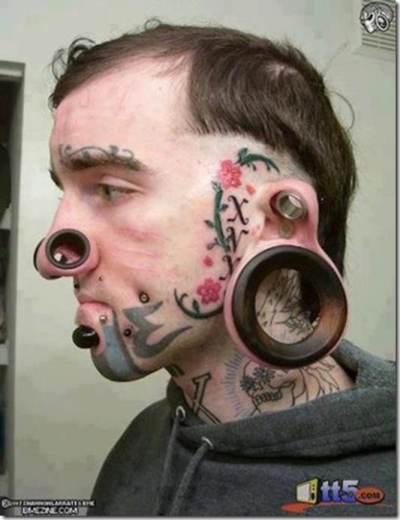
Angelina Jolie
Tattoos and body piercings are all the rage today. Movie stars and singers are covered with tattoos. Ordinary people in the streets and on T.V. are covered with tattoos — not just young people, but even older folks.
But did you know that Rolling Stone magazine quoted famous tattoo artist Paul Booth as saying that while he is tattooing people, “he allows his clients’ demons to help guide the needle”?

William M. Sudduth Sr. is the president of Righteous Acts Ministries (ramministry.org) and author of What’s Behind the Ink?, a book about the spiritual aspects of tattooing, piercing and other fads.
He spent nearly two years researching the origins and history of tattoos and piercing — of Pacific Islanders, Native Americans, Europeans, Mid-Easterners, Asians and Africans. He discovered that all primitive pagan cultures throughout history and on every continent subscribed to some form of body modification or mutilation, usually involving tattoos and/or piercing. In most cases the practice was a part of demon worship.
In his article, “The Dark Side of Tattoos,” for Charisma Magazine, Dec. 31, 2009, Sudduth describes how he first became interested in the fashionable trend of tattoos:
I had never given the subject of tattoos much thought other than occasionally to regret getting mine—until my wife, Janet, and I were ministering in New Zealand in 2003. New Zealand was settled more than 1,000 years ago by a primitive Polynesian people called the Maori. They were headhunters and cannibals who worshipped demon gods. The Maori tattoo most of their bodies, including their faces, which they carve flesh from as a wood carver would etch wood to create a design. Then they apply ink.
On a day off we went sightseeing with a local pastor. He took us to a Maori village. Inside the entrance of the village was a meeting house, and above the entrance was a statue of a demon, the face of which was carved with the same pattern as the men’s faces. I immediately came to the realization that these people had carved their faces to look like the deity they worshiped.
What he saw among the Maori led Sudduth to undertake a two-year research. He discovered that the Maori were not unusual. Instead, “in every culture tattoos were used as a means of invoking, appeasing or glorifying demon gods.” Those cultures include:
1. Headhunters from the Philippines, Taiwan and other Pacific islands tattooed themselves to appease the gods before the headhunt and to commemorate their success afterward.
2. South American headhunters also used tattoos as part of their rituals.
3, The Hawaiians have actual tattoo gods they consult before doing a tattoo.
4. The Chinese and Japanese used tattoos to ward off evil spirits, to appease different gods and, like the Romans, to identify or “brand” criminals. (Roman slaves were tattooed as a sign of ownership, often marked, “Tax Paid.”)
5. Native Americans tattooed themselves and their captives. The Inuit tattooed themselves upon arriving in the cold arctic regions to appease the gods so they would allow them to settle there and survive in the harsh climate.
6. In the Mideast, Babylonian and Canaanite and Hebrew shrine prostitutes tattooed themselves as part of their worship. Baal worshipers wore tattoos on their hands to gain power from Baal.
7. In India, shrine prostitutes tattooed themselves to look like the various gods they worshiped. In primitive areas of India the wife of the village sorcerer is the tattoo artist.
8. Because of their dark skin, black Africans didn’t use tattoos as much as they used scarification — cutting the skin with a sharp instrument and then rubbing it with ashes or caustic plant juices to form permanent blisters. Dark pigments, such as charcoal or gunpowder, are then rubbed into the wound to provide emphasis. The wounds are periodically reopened to enhance the raised scar effect. Other African traditions involve extreme forms of body piercing. Lips and ears are pierced and objects implanted inside, causing the lip or ear tissue to elongate and conform to the shape of the object. Ethiopian women wear a lip plate, which causes the mouth to protrude to resemble the beak of the spoonbill, a creature they worship.
Sudduth concludes:
The letting of blood and body modification have always been associated with pagan worship and witchcraft. Pagans and Christians alike know there is power in the blood. In spite of the current interest in tattoos even in the church, all research points to one conclusion: The root of tattooing never changes; it is, and always has been, a pagan spiritual activity. […]
Today in our culture and society we see an explosion of fads such as tattoos and piercings. Though I don’t fully understand it, Satan is attempting to mark as many people as he can through these means. Perhaps on the day of judgment the accuser of the brethren, the devil, will stand before God and try to claim those so marked as his own.
Or perhaps Satan is encouraging people of all cultures to mar their bodies through some form of mutilation because he knows we are made in God’s image, and he hates God and anything that resembles God. […]
Leviticus 19:28 gives us the “rule” for tattoos. It says, “‘You shall not make any cuttings in your flesh for the dead, nor tattoo any marks on you: I am the Lord”’ (NKJV).
When God first gave this command to the Israelites, He was drawing a line of demarcation between His chosen people and the Egyptians, whose land they had just left, and the Canaanites, whose land they were about to enter. Both of these cultures were steeped in witchcraft and the occult. Both openly worshiped and served demon gods, and both used tattoos as part of their idolatry and pagan worship. God was trying to protect the Israelites from opening themselves up to demonic influence.
We too are God’s people, and He wants us to “come out from among them” (2 Cor. 6:17). He wants us to separate ourselves from the world and the world’s fads. When we do that, we will avoid doing things to our bodies that God never intended us to do—and that includes getting tattoos.
Let me make it clear that there is absolutely no such thing as a Christian tattoo. In fact, the mere term “Christian tattoo” is an oxymoron! A tattoo may be a religious symbol, but there is nothing Christian about it.
If we truly belong to Christ, we should know and understand that our bodies are not our own. Engaging in the practice of body modification indicates that we believe the opposite. Yet the Bible clearly tells us: “Do you not know that your body is the temple of the Holy Spirit who is in you, whom you have from God, and you are not your own? For you were bought at a price; therefore glorify God in your body” (1 Cor. 6:19-20).
[…] If you already have a tattoo or piercing and are wondering what to do now that you know the truth, here are some steps you can take. First, repent to God for violating Scripture and for bloodletting, which is witchcraft. Also, repent for defiling the temple of the Holy Spirit.
Then renounce the spirits behind the tattoo or piercing. Witchcraft and rebellion are a given, but many tattoos have images that need to be addressed. Sexual tattoos may invite a spirit of perversion, a skull and cross bones a spirit of death, a religious tattoo a spirit of religion and so on. If you have a piercing in other than an ear lobe, remove it and repent for defiling your temple. And whether it’s a tattoo or a piercing, anoint it with oil and break any assignment of the enemy that came in through the modification of your body.
See also:
- Tattoo Ink Contains Carcinogens
- New perversity: body modification to look like the devil
- Electronic “tattoo” tracks patients’ vital signs
- New Hollywood cult is the old Satanic cult
~Eowyn

